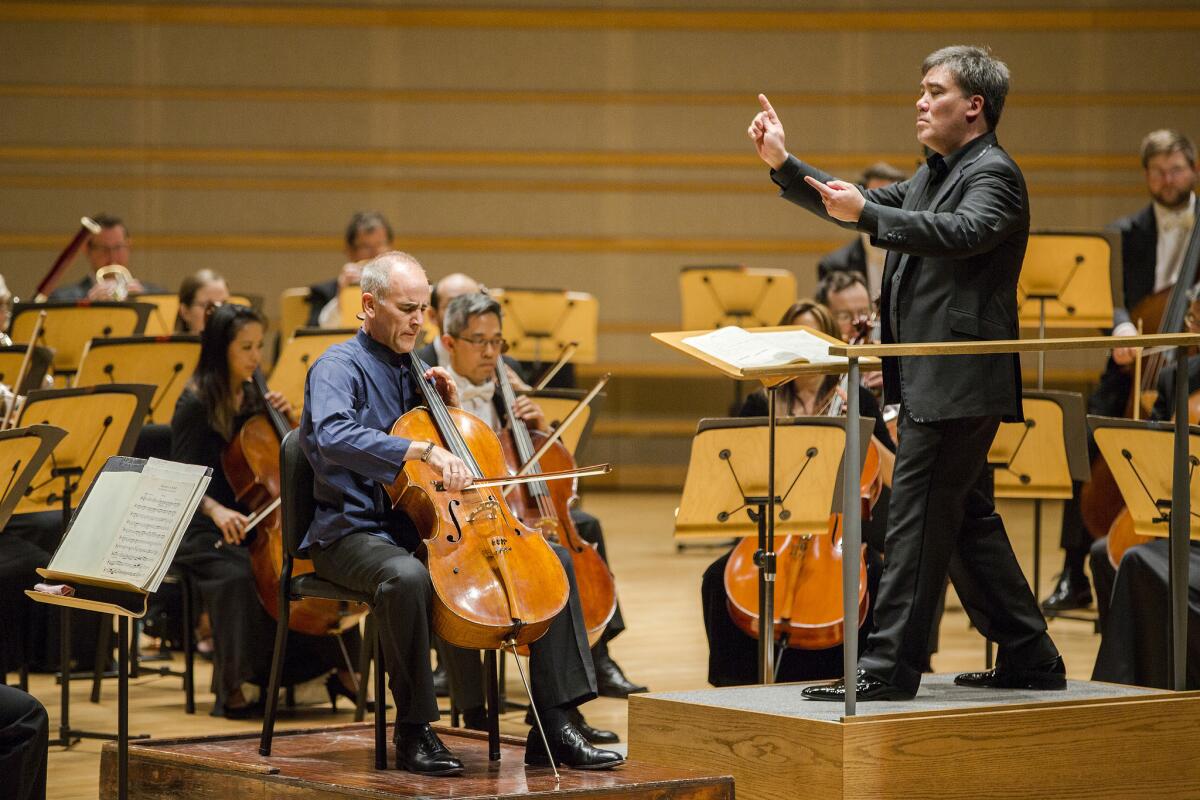Review: In Costa Mesa, the New York Philharmonic runs through the routine

- Share via
For a significant proportion of its 174-year history, America’s oldest orchestra has been its most important. That includes such obvious years as those when Mahler and Toscanini and Bernstein and Boulez were music director. But there has never been a time when the New York Philharmonic hasn’t mattered.
Brahms, say, premieres his Second Symphony in Vienna in 1877 and less than a year later, the New York Philharmonic plays it in New York. That was, even back then, business as usual.
Tuesday night the orchestra began a short West Coast tour at the Renée and Henry Segerstrom Concert Hall in Costa Mesa with its music director, Alan Gilbert, and a program that included Brahms Second. Surprisingly, the program notes made no note of the orchestra’s bragging rights for the Second’s U.S. premiere.
The program — which also featured the orchestra’s principal cellist, Carter Brey, in Schumann’s Cello Concerto — was a repeat of what the orchestra played at home last week, with one exception. The original program opened with the world premiere of a commissioned score, Frank Krawczyk’s “Après.” For the tour more Brahms, the “Tragic” Overture, replaced little-known Krawczyk (reportedly at the insistence of one of the other tour presenters, not Costa Mesa’s Philharmonic Society).
Sure, ticket-wise, it’s a tough world out there. But this is the New York Philharmonic! Since when is that not reason enough to go?
There is worry in orchestra-land that the New York Philharmonic has, for the historical moment, lost its way. Now in his penultimate season as music director, Gilbert has not fully managed to instill a sense of purpose in the orchestra, although not for want of trying. He has significantly revitalized the repertory and given a meaningful prominence to new music that had been lacking in the last two music directors, Kurt Masur and Lorin Maazel.
On May 23, the orchestra begins a three-week biennial, a Gilbert initiative, with a massive amount of relevant new work played all over New York City. Gilbert’s latest recording with the New York Philharmonic documents vivid performances of four intense orchestral pieces by its previous composer in residence, Christopher Rouse. The current composer in residence and consultant on the biennial is Esa-Pekka Salonen. Enough said.
The question on many critics lips is how much of Gilbert’s progressive spirit will incoming music director Jaap van Zweden be able to, or even care to, sustain?
From the evidence of the Brahms performances Tuesday, the New York Philharmonic remains a top-flight ensemble, strong in every section. Equally heartening is the fact that Gilbert, who had seemed too green for the job when he began in 2009 at age 42, has grown considerably as a conductor. He brought expressive muscle to both Brahms scores, emphasizing rich low string sonorities and spectacular brassiness. Despite having no business being on the program, the overture was particularly compelling.
But that is not enough said. There was little about the evening that said New York Philharmonic. The ensemble may display an identifiable American brashness, but this concert was not all that different from what any number of American, European or Japanese orchestras might have produced. The Brahms-Schumann program was shockingly conventional. (It has a barely more imaginative companion program that will be played in San Diego and San Francisco, pairing the seventh symphonies of Beethoven and Sibelius.) The fearless thing to have done would have been for Gilbert to show us the New York accent he and his orchestra give Salonen’s “LA Variations,” which they performed earlier this season.
Another obvious choice might have been a Rouse symphony as an excellent New York companion to Brahms. Instead we were left with German music written within a less than 30-year span in the second half of the 19th century and a disappointing Schumann concerto.
Hiring Brey as principal cellist in 1996 was a coup for the orchestra. At the time he was a rising young soloist, especially eloquent in recital and chamber music. But he seemed curiously out of place as soloist in the Schumann. His careful tone and understated phrasing hardly suited the orchestra when it entered into bruising mode.
Gilbert’s effectively forthright and often quite loud Brahms had no problem wowing its audience. And in that, Bray’s cello section proved a Brahmsian’s dream, deep amber in tone and never mushy. The horns let you know they were there, most of the time in a good way.
But Gilbert also puts himself in contention with history with Brahms Second, which the orchestra has recorded many times. Fritz Reiner’s in 1960 and Bernstein’s two years later are ones that burst with personality. On the New York Philharmonic website you can find a copy of Bernstein’s annotated score, showing the way he created his luscious lilt and irresistible panache.
There is no expectation that Gilbert might — or need to — live up to this. His perfectly satisfying Brahms is good enough for the needs of modern audiences and orchestras for a routine night at the symphony. The New York Philharmonic is not, however, an ordinary orchestra and must never, as it is doing on this humdrum tour, act like it is.
More to Read
The biggest entertainment stories
Get our big stories about Hollywood, film, television, music, arts, culture and more right in your inbox as soon as they publish.
You may occasionally receive promotional content from the Los Angeles Times.











